Imagine having the ability to reach out to potential customers who have already shown interest in your website. With RLSA ads, this dream can become a reality.
RLSA, or Remarketing Lists for SearchAds, is a powerful feature of GoogleAds that allows you to strategically target previous website visitors with tailored and relevant ads. By understanding your audience, tracking their behavior, and optimizing your bids and messaging, you can significantly boost your conversions and revenue.
In this article, we will dive into the world of RLSA ads and explore how this game-changing feature can take your advertising strategy to the next level.
Table of Contents
rlsa ads
RLSA ads, also known as Remarketing Lists for Search Ads, are a powerful Google Ad feature that enables businesses to target users who have previously visited their website with relevant ads on Google and the Google Display Network. By creating specific RLSA audiences based on user actions such as product views or sign-ups, businesses can target a highly valuable audience that is more likely to convert.
This targeted approach leads to increased conversions, revenue, and profits. To make the most of RLSA campaigns, it is important to understand your audience, create buyer personas and customer journey maps, and modify bids based on audience demographics.
RLSA allows businesses to track user behavior and retarget ads to users who have previously interacted with their website. Strategies for using RLSA include bid adjustments, matching ad messaging with user actions, upselling to converted users, and bidding for broad search terms.
Remarketing lists for search ads can be used to customize search campaigns and bid on keywords that attract recently visiting customers. This not only increases brand awareness but also helps establish better connections with potential customers and improve return on investment.
Setting up RLSA campaigns involves tagging the website or app with a Google Ads tag to create remarketing lists which can then be used for bidding and targeting ad groups or campaigns. To make RLSA campaigns more effective, it is important to segment audiences, tailor ad copy to returning customers, and personalize the shopping experience.
Demographic targeting further strengthens audience personas and allows for customized bids for specific demographic groups. Monitoring and growing the audience size for remarketing lists is crucial, as is conducting detailed keyword research.
RLSAs are highly effective in delivering personalized and relevant content to drive conversions. Marketers should not overlook the benefits of remarketing lists for search ads and should combine them with other marketing strategies for maximum impact.
Key Points:
- RLSA ads are a feature on Google Ads that target users who have visited a business’s website.
- Businesses can create RLSA audiences based on user actions like product views or sign-ups.
- RLSA campaigns increase conversions, revenue, and profits by targeting a valuable audience.
- Strategies for using RLSA include bid adjustments, matching ad messaging to user actions, and bidding on broad search terms.
- RLSA can be used to customize search campaigns and bid on keywords that attract recently visiting customers.
- Setting up RLSA campaigns involves tagging the website or app with a Google Ads tag and segmenting audiences.
Sources
https://blog.hubspot.com/marketing/rsla-remarketing-lists-for-search-ads
https://neilpatel.com/blog/rlsa/
https://support.google.com/analytics/answer/6212951?hl=en
https://www.wordstream.com/blog/ws/2015/03/12/remarketing-lists-for-search-ads
Check this out:
💡 Pro Tips:
1. Utilize negative remarketing lists: In addition to targeting specific remarketing lists, consider creating negative remarketing lists to exclude users who have already converted or taken a desired action. This can help optimize your RLSA campaigns and focus on acquiring new customers.
2. Experiment with ad sequencing: Take advantage of ad sequencing options within RLSA campaigns to deliver a sequential series of ads that build upon each other. This can help create a more personalized and impactful user experience.
3. Test different bid adjustments: Continuously test and experiment with different bid adjustments for your RLSA campaigns. Adjust bids based on factors such as time of day, device, and audience demographics to maximize your ROI and reach the most valuable users.
4. Leverage dynamic remarketing: Consider using dynamic remarketing to show personalized ads featuring specific products or services that users have previously shown interest in. This can help re-engage users and increase the likelihood of conversion.
5. Combine RLSA with other targeting methods: Don’t limit your targeting solely to RLSA ads. Combine RLSA with other targeting methods, such as keyword targeting or demographic targeting, to create a comprehensive and effective ad strategy that reaches a wider range of potential customers.
Introduction To RLSA Ads
RLSA, or Remarketing Lists for Search Ads, is a powerful feature offered by Google Ads that allows businesses to target users who have previously visited their website with relevant ads on Google and the Google Display Network. This means that businesses have the opportunity to reconnect with potential customers who have already shown interest in their products or services.
By tailoring ad campaigns specifically to these users, businesses can increase their chances of conversion and ultimately drive more revenue and profits.
Creating Specific RLSA Audiences
One of the key advantages of RLSA is the ability to create specific audiences based on user actions. Businesses can identify user behaviors that indicate a higher likelihood of conversion, such as product views or sign-ups, and target those users with tailored ads.
This allows for a more personalized advertising experience, increasing the chances of capturing users’ attention and driving them to take the desired action.
Benefits Of Targeting A Valuable Audience
Targeting a valuable audience through RLSA can have numerous benefits for businesses. By focusing on users who have already shown interest in their products or services, businesses can significantly increase their chances of conversion.
These users are more likely to be receptive to relevant advertising messages, which in turn boosts the effectiveness of campaigns. Additionally, targeting a valuable audience can lead to increased brand awareness and better connections with potential customers, fostering long-term relationships and driving repeat business.
Best Practices For RLSA Campaigns
To maximize the effectiveness of RLSA campaigns, it is crucial to follow best practices. Understanding your audience is key – businesses should create buyer personas and customer journey maps to gain insights into their target market.
This allows for more accurate ad targeting and messaging. Modifying bids based on audience demographics is another important tactic.
By identifying specific demographic groups that are likely to convert, businesses can adjust bids accordingly and allocate their advertising budget more strategically.
Tracking User Behavior With RLSA
One of the strengths of RLSA is its ability to track user behavior and target ads to users who have previously interacted with a website. By analyzing user actions and behaviors, businesses can gain valuable insights into their audience and refine their targeting strategies.
Understanding which pages or products users show interest in can help businesses tailor their messaging to align with these specific actions, increasing the relevancy and impact of their ads.
Strategies For Maximizing RLSA Effectiveness
There are several strategies that businesses can employ to maximize the effectiveness of RLSA campaigns. Bid adjustments are a common tactic – bidding higher for users who have previously shown stronger intent to convert can increase the chances of capturing their attention and driving them back to the website.
Matching ad messaging with user actions is another effective strategy. By aligning the content of the ad with the specific actions users have taken on the website, businesses can create a more compelling and personalized advertising experience.
Customizing Search Campaigns With RLSA
RLSA can be used to customize search campaigns by bidding on keywords that attract recently visiting customers. By specifically targeting these keywords, businesses can increase their visibility to users who are already familiar with their brand or products.
This can lead to higher conversions and better return on investment. Furthermore, demographic targeting can help create stronger audience personas and allows for customized bids for specific demographic groups, further enhancing the effectiveness of RLSA campaigns.
Tips For Successful RLSA Implementation
When implementing RLSA campaigns, it is important to keep a few tips in mind. Audience segmentation is key – by dividing the audience into smaller, more targeted groups, businesses can tailor ad content more effectively.
It is also important to personalize the shopping experience for returning customers. By showing them relevant products or promotions based on their previous interactions, businesses can enhance the user experience and drive conversion.
Regularly monitoring and growing the audience size for remarketing lists, as well as conducting detailed keyword research, are essential for maintaining the success of RLSA campaigns.
In conclusion, RLSA ads provide businesses with a powerful tool to reconnect with users who have shown interest in their products or services. By creating specific audiences, understanding their behavior, and implementing best practices, businesses can maximize the effectiveness of their RLSA campaigns.
By combining RLSA with other marketing strategies, businesses can further enhance their overall marketing efforts and drive sustainable growth.












